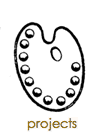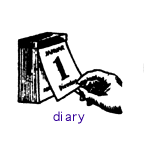
| GHOSTSHIP / THE TITANIC PROJECT |
| © 1991-2008 by Melissa Gould (MeGo) |

| GHOSTSHIP / THE TITANIC PROJECT is a monumental installation piece recreating the ill-fated ocean liner TITANIC as a floating deck plan (in its original size — 882 feet long; 92 feet wide), projected in light onto the surface of the Hudson River at Pier 59 (due west of West 18th Street), the ship's intended destination in 1912. The project could be viewed from the Chelsea Piers Sports Complex, now at the site. This solar-powered nocturnal installation (the light projection turns on at sundown and off at dawn) would be the ultimate memorial — an "eternal" light viewable only between dusk and the break of day. The inauguration of GHOSTSHIP / THE TITANIC PROJECT would be on April 15, 2012, to coincide with and commemorate the 100th anniversary of TITANIC's maiden (and fatal) voyage, bringing the great ship back to the slip at which she was expected but never arrived, in a conceptual full circle. John Maxtone-Graham — eminent maritime historian and the leading authority on the history of ocean liners — remarked on GHOSTSHIP / THE TITANIC PROJECT: "And the image of an illuminated, full-scale Titanic deck plan, floating radiantly within a Manhattan slip, should serve as its own reward, an evocative memorial of incalculable power." [Complete article (on earlier incarnation of the project) here.] I am interested in provoking historical memory as well as in stimulating the imagination, compelling viewers to envision a "New York That *Should* Have Been." GHOSTSHIP / THE TITANIC PROJECT proposes a monumental twist of time and fate. Like my installation FLOOR PLAN, this project is part of a series called MEMORIAL LIGHTSCAPES, conceptual landscapes dedicated to the memory, both personal and collective, of "lost spaces" — that is, places with a particular psychological weight because they no longer exist and where their disappearance is the result of tragic events. These projects propose the installation of life-size "in-the-night-landscape" drawings made of light that are based on the actual architectural blueprint plans or historic maps of the lost spaces they represent; geographical juxtapositions as a counterpoint of memory. |



